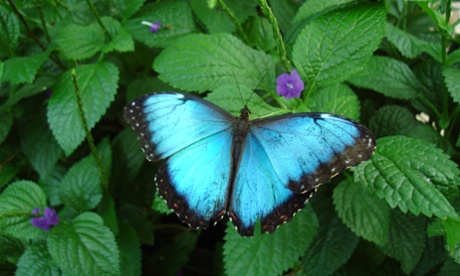Structural colours are more visible and vivid than those that use pigments – as many examples from the natural world demonstrate. But sometimes pure white is what is required

Blue morpho (Morpho peleides) butterfly at the Niagara Parks Butterfly Conservatory, Niagara Falls, Ontario, Canada. Photograph: Rlevse/Wikimedia
White means that all wavelengths of light are scattered equally and in all directions. The arguments above suggest that the chitin structures can’t be well-organised and must be arranged without the presence of any periodicity whose dimensions are comparable to light. Electron microscopy of the beetle cases reveals a dense and disordered packing of chitin fibrils (this fibrillar structure confers some directional sense) within each scale. This structural characterisation has been combined with spectral analysis and light-path modelling to show that for those beetles that exhibit this intense whiteness (Cyphochilus and Lepidota stigma) light is scattered multiple times very efficiently to give equal scattering over a broad range of wavelengths. The efficiency of this process means that these beetles can achieve this using much less material, and so much less weight, than in other organisms, something that is crucially important for a flying insect.
Why should we care? In everything from the whiteness of paper to making an efficient sun-block, humans are seeking substances that lead to high whiteness. In sunscreens, titanium dioxide is the material of choice and there is a great push to find more sustainable and cheaper alternatives. Turning to the natural world for inspiration to find a suitable replacement is an example of biomimetics, where the mechanisms of nature are copied via manufactured routes. Chitin is a good starting material because there is a great deal of it around, much of it as food waste (discarded prawn and lobster shells for instance). So, maybe understanding the packing of chitin fibrils in white beetles can lead to a low-cost, low-weight and renewable substitute for titanium dioxide.
As for structural colours, they too are providing inspiration for man-made alternatives. In this case one target is making banknotes that are hard to counterfeit by using a synthetic block copolymer. These are also long chain molecules, like chitin, but made up of two blocks A and B of different chemistries, the length of each of which can be finely tuned to give polymers of different total molecular weights. When thin films of such block copolymers are spun from solution the A and B blocks segregate but, because they are chemically linked together, there are only certain structures that are geometrically possible.
Recalling the butterfly-scale layered structures, one of the allowed morphologies is made up of alternating stripes of A and B. The repeat distance of these layers will be determined with great precision by the chemistry, allowing control of which wavelengths are strongly scattered. Furthermore, by using a shear force to introduce some directionality into the alternating stripes, the angular response can also be controlled. The net effect is to produce an optical component that is equivalent to a narrow transmission optical filter.
This approach has been developed (see here for an example from work done at the University of Sheffield) as a possible cheap and easy way to coat banknotes to prevent forgery. By blending high and low molecular weight variants of chemically identical block copolymers the layer spacing – and hence the colour seen – can be fine-tuned. Because the chemistry of preparing the block copolymers is so complex it’s assumed forgers won’t be able to master it precisely enough to fool people by the appearance of their notes.
Many groups around the world are exploring biomimetic applications. We have a lot to learn from that humble but iridescent beetle that you may spot crossing your path and from its relatives across the taxonomy of the natural world.
The above story is based on materials by The Guardian.
Note: Materials may be edited for content and length. For further information, please contact the source cited above.
Copyright © 2024 International Society of Bionic Engineering All Rights Reserved
吉ICP备11002416号-1









